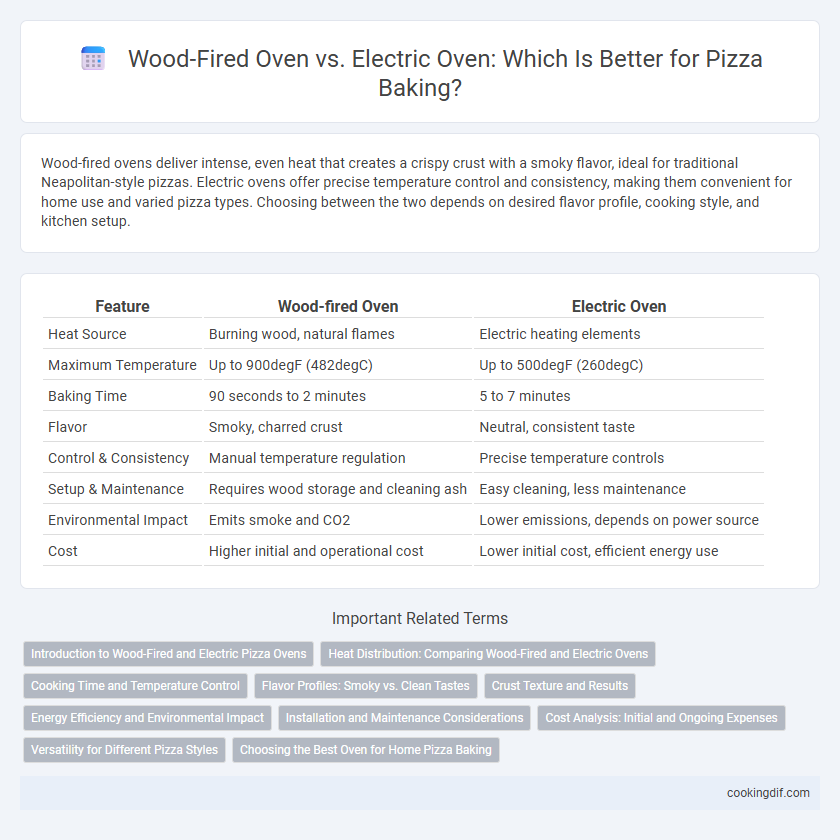Wood-fired ovens deliver intense, even heat that creates a crispy crust with a smoky flavor, ideal for traditional Neapolitan-style pizzas. Electric ovens offer precise temperature control and consistency, making them convenient for home use and varied pizza types. Choosing between the two depends on desired flavor profile, cooking style, and kitchen setup.
Table of Comparison
| Feature | Wood-fired Oven | Electric Oven |
|---|---|---|
| Heat Source | Burning wood, natural flames | Electric heating elements |
| Maximum Temperature | Up to 900degF (482degC) | Up to 500degF (260degC) |
| Baking Time | 90 seconds to 2 minutes | 5 to 7 minutes |
| Flavor | Smoky, charred crust | Neutral, consistent taste |
| Control & Consistency | Manual temperature regulation | Precise temperature controls |
| Setup & Maintenance | Requires wood storage and cleaning ash | Easy cleaning, less maintenance |
| Environmental Impact | Emits smoke and CO2 | Lower emissions, depends on power source |
| Cost | Higher initial and operational cost | Lower initial cost, efficient energy use |
Introduction to Wood-Fired and Electric Pizza Ovens
Wood-fired pizza ovens use high-temperature combustion of wood to create an intense, smoky heat that cooks pizza quickly, producing a crispy crust and unique flavor. Electric pizza ovens offer consistent temperature control and ease of use, making them ideal for indoor environments and commercial settings. Both ovens have distinct advantages in pizza baking, with wood-fired ovens excelling in traditional flavor and electric ovens providing precision and convenience.
Heat Distribution: Comparing Wood-Fired and Electric Ovens
Wood-fired ovens provide intense, radiant heat with uneven temperature zones that create a unique char and smoky flavor, ideal for Neapolitan-style pizzas. Electric ovens offer consistent and evenly distributed heat, allowing for precise temperature control which results in uniform cooking throughout the pizza. The choice of oven impacts crust texture and flavor development, with wood-fired ovens producing a crispier, slightly blistered crust compared to the more evenly baked crust from electric ovens.
Cooking Time and Temperature Control
Wood-fired ovens reach temperatures of 700-900degF, cooking pizzas in 90 seconds to 3 minutes with intense heat that produces a crispy crust and smoky flavor. Electric ovens typically operate between 450-500degF, requiring 8-12 minutes for baking, offering precise temperature control and consistent heat distribution. Choosing between them depends on prioritizing fast cooking and traditional flavor or steady temperature management and convenience.
Flavor Profiles: Smoky vs. Clean Tastes
Wood-fired ovens impart a distinctive smoky flavor to pizza due to the combustion of natural wood, which infuses the crust and toppings with rich, complex aromas. Electric ovens, by contrast, produce a cleaner taste profile, allowing the natural flavors of fresh ingredients to stand out without additional smokiness. The choice between wood-fired and electric ovens significantly influences the sensory experience, with wood-fire delivering a traditional, robust flavor and electric ovens offering a more subtle, pure taste.
Crust Texture and Results
Wood-fired ovens produce pizza crusts with a distinctive charred, smoky flavor and a crisp, airy texture due to their high temperatures reaching up to 900degF (480degC), which creates rapid oven spring and caramelization. Electric ovens typically operate at lower temperatures around 500degF (260degC), resulting in a more uniform, less blistered crust that can be thicker and chewier. The thermal mass and radiant heat of wood-fired ovens contribute to a unique crust texture favored by traditional Neapolitan-style pizzas, whereas electric ovens provide consistent baking results suitable for various dough recipes.
Energy Efficiency and Environmental Impact
Wood-fired ovens, known for their high combustion temperatures, often consume more energy and emit higher levels of carbon dioxide due to burning wood, impacting air quality and deforestation concerns. Electric ovens offer greater energy efficiency by converting electricity directly into heat, producing lower emissions when powered by renewable sources, thus reducing the carbon footprint associated with pizza baking. Choosing electric ovens can align with sustainable practices, especially in regions with clean energy grids, while wood-fired ovens provide traditional flavor but with a larger environmental cost.
Installation and Maintenance Considerations
Wood-fired ovens require professional installation due to their heavy materials and ventilation needs, along with regular cleaning to manage ash and soot buildup. Electric ovens offer simpler installation, often just needing a dedicated electrical circuit, and require less maintenance as they do not produce combustion residue. Choosing between the two depends on available space, ventilation options, and long-term upkeep preferences.
Cost Analysis: Initial and Ongoing Expenses
Wood-fired ovens typically require a higher initial investment, ranging from $1,500 to $10,000 depending on size and materials, while electric ovens are generally more affordable upfront, costing between $500 and $3,000. Ongoing expenses for wood-fired ovens include the cost of quality hardwood fuel, averaging $20 to $50 per week, and regular maintenance to prevent damage from heat and soot, whereas electric ovens incur lower energy costs and minimal upkeep. Considering efficiency, electric ovens offer consistent temperature control reducing energy waste, which can lead to lower operational costs over time compared to the variable fuel consumption of wood-fired ovens.
Versatility for Different Pizza Styles
Wood-fired ovens excel in achieving high temperatures and imparting smoky flavors ideal for Neapolitan and traditional Italian pizzas, enhancing crispiness and char. Electric ovens offer precise temperature control and consistent heat distribution, making them suitable for a wider range of pizza styles, including deep-dish and thin crust varieties. Their versatility allows for customization of baking environments to accommodate diverse dough textures and topping combinations.
Choosing the Best Oven for Home Pizza Baking
Wood-fired ovens reach temperatures above 800degF, creating a crispy crust and smoky flavor that mimics traditional Neapolitan pizza, making them ideal for authentic home pizza baking. Electric ovens provide precise temperature control up to 500degF, offering convenience and consistent results, especially for those with limited outdoor space. Choosing the best oven depends on factors like desired pizza style, available space, ease of use, and budget constraints.
Wood-fired oven vs Electric oven for pizza baking Infographic

 cookingdif.com
cookingdif.com